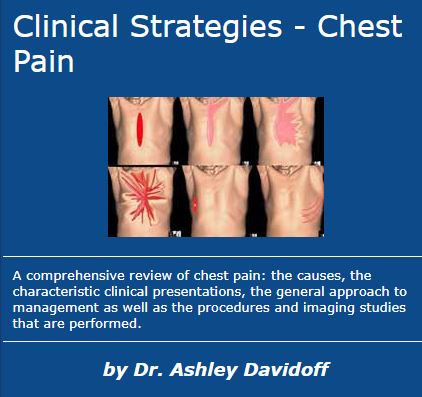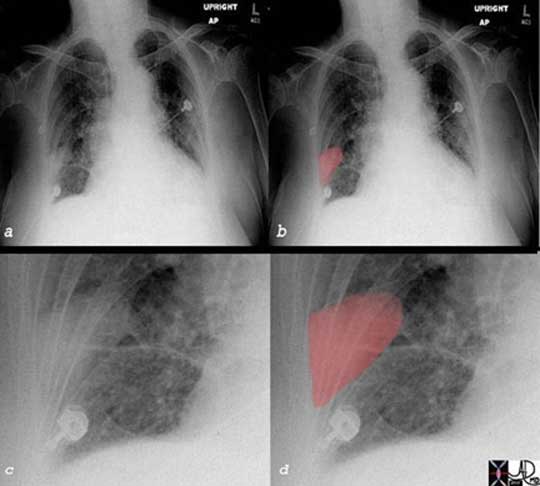Dima Quraini, M.D., Ashley Davidoff, M.D.,
Learning Objectives
- Describe the various causes of chest pain
- Recognize coronary artery anatomy
- Discuss the physiology and pathophysiology of the heart
- Discuss the characteristic clinical presentations of chest pain
- Recognize the usual diagnostic algorithm and procedures that are performed
- Explain the general approach to the management
Introduction
Chest pain is defined as the painful sensation that is classically felt in the front part of one’s body, between the neck and the upper abdomen. It can have many causes that range from life-threatening conditions such as myocardial infarction and aortic dissection, to more benign conditions such as indigestion, heartburn, and gastroesophageal reflux, costochondritis, and muscular aches. We do, however, include in the module back pain that may reflect significant chest disease such as pulmonary embolism, pleurisy, and aortic dissection, while also sometimes reflecting abdominal disease such as cholecystitis and kidney stones.

In the above diagram and through the text, we attempt to depict the nature of the pain diagrammatically. The more severe pains are shown in brighter red and the speculated shapes reflect sharper pain. Thus, the top left image is severe burning, retrosternal pain characteristic of gastroesophageal reflux disease (GERD) with esophagitis. The top middle image is a pressure-type pain that radiates to the neck, characteristic of angina and sometimes seen in esophageal spasm. The top right image is a more diffuse discomfort or pressure and is seen in angina and myocardial infarction. The bottom left image is sharp, lancinating, severe, almost devastating pain characteristic of acute aortic dissection. The focal sharp pain in the middle image, aggravated by deep inspiration, is characteristic of pleuritic pain and pericarditis, while the pain along a dermatome on bottom right is seen in herpes zoster (shingles).
Courtesy of: Ashley Davidoff, M.D.
Background
Chest pain is one of the most common complaints encountered in the emergency room, hospital ward or physician?s office. It is essential as a caregiver to have a thorough understanding of the variety of chest pain syndromes in order to distinguish between life-threatening disease and the benign entities. Meticulous attention to the history and the characteristics of the pain often is the most important aspect in diagnosis. Patients who are mistakenly discharged after presenting with chest pain secondary to myocardial infarction suffer twice the mortality rate than patients who were admitted. Also, missed diagnosis of serious diseases lead to cumbersome legal costs. However, many other diseases associated with low short-term mortality present with chest pain rendering the hospitalization of all patients presenting with such a complaint inconvenient and costly to an overburdened health system.
Structural Considerations
The chest is composed of muscle, bone and nerves that create the chest wall that itself harbors the heart, the pericardium, the large vessels, the lungs, the pleura and the esophagus. Any process involving these structures can cause chest pain. The pain may be visceral as in cardiac pain and esophageal pain, but on the other hand may be somatic when the pericardium, pleura, or skin is involved.
Causes and Predisposing Factors
The differential diagnosis of chest pain is large and encompasses diseases from many systems. Inflammatory, infectious, neoplastic, traumatic, circulatory, immune, idiopathic disorders can all be the cause of chest pain. A well-obtained clinical history is crucial in determining the origin of the pain and in guiding the ensuing management. The clinical history should focus on the characteristics of the pain, the time of onset, the aggravating and relieving factors and any accompanying symptoms. The patient?s prior medical history is also important as it may make one diagnosis more likely than another.
Past Medical History and Family History
The patient?s prior medical history is important as it can provide clues about the cause of the patient?s current presentation. Patients with known coronary artery disease, hypertension and diabetes mellitus are at increased risk of undergoing an acute coronary syndrome. A family history of coronary artery disease, particularly in young patients (men less than 55 years old and women less than 60 years old), predispose the patient to coronary disease. Younger patients presenting with chest pain may also suffer from myocardial ischemia or infarction particularly in the context of cocaine use. Therefore, a detailed history of substance use including tobacco and alcohol consumption should be obtained. A urine toxicology screen can be checked if there is a suspicion of drug use.
Risk Factors
Risk factors for other causes of chest pain should also be sought. For example, a prior episode of deep venous thrombosis or pulmonary embolus, sedentarism, a recent surgical intervention or underlying malignancy may suggest a pulmonary embolism as the cause of a patient’s chest pain. A young, tall patient who presents with an acute onset of chest discomfort and shortness-of-breath is unlikely to be undergoing an acute coronary syndrome. He or she would be more likely to have a spontaneous pneumothorax and Marfanoid, so aortic dissection must be considered. Uncontrolled hypertension predisposes patients to aortic dissection.
Cardiovascular Causes of Chest Pain: Myocardial Ischemia and Infarction
Myocardial ischemia is one of the most common and serious causes of chest pain in patients. Approximately 20% of patients presenting to an emergency room with chest pain have underlying myocardial ischemia or infarction. Although most patients presenting with chest discomfort are discharged without a diagnosis or a non-cardiac cause to their pain, it is crucial to seek the symptoms and signs of myocardial infarction as it carries a high mortality if left untreated. However, with early recognition and the timely institution of appropriate therapy, the mortality rate is significantly reduced.
The disparity between oxygen supply and consumption may result from coronary atherosclerosis, coronary thrombus, coronary vasospasm or embolus. Thrombus formation secondary to a ruptured plaque leads to an abrupt loss of oxygen supply to the heart muscle supplied by the diseased coronary artery and leads to unstable angina or myocardial infarction.
Other rarer causes of acute occlusion of oxygen supply to the myocardium include a coronary embolism, coronary dissection or coronary vasculitis. Chronic angina, on the other hand, is due to the chronic narrowing of coronary arteries due to atherosclerosis. When oxygen demand is increased in the setting of tachycardia, such as would occur during exercise or stress, the oxygen supply is limited by atherosclerosis and therefore is unable to meet that increase in oxygen demand. This disparity between oxygen supply and demand leads to myocardial ischemia and chest pain.
Cardiovascular Causes of Chest Pain: Angina
The classic presentation of myocardial ischemia was first described by Dr. William Heberden in a lecture before the Royal College of Physicians in 1768. He claimed that ?the seat of it, and sense of strangling and anxiety, with which it is attended, may make it not improperly be called angina pectoris?. The pain is usually precipitated by exercise or emotional stress and lasts between 30 seconds and 30 minutes. The onset is acute, intensifies within minutes and is characterized by adjectives such as tightness, pressure, or heaviness, most commonly in the retrosternal region but it may involve the precordium. It is aggravated by continued exercise and is characteristically relieved when the physical or emotional stress is abated or following administration of nitroglycerine. The discomfort may radiate to the neck, jaw, or left arm. Associated symptoms include an impending sense of doom originally described as “angor animi” which literally means anguish of the soul. This sensation sometimes accompanies other life-threatening situations when there is massive outpouring of catecholamines, such as aortic dissection and pulmonary embolism. Associated symptoms include shortness of breath, nausea and diaphoresis. It is usually, although not necessarily, precipitated by exercise or emotional stress. The episodes of angina recur usually with the same degree of exercise, and patients can predict their exercise tolerance. These episodes can also progress in frequency and can present while the patient is at rest, but do not usually wake the patient from sleep.
An important distinction should be made between patients presenting with a single and acute episode of chest pain versus patients who chronically develop chest pain on exertion. The latter is termed stable angina and can be managed medically unless the patient is symptomatic despite optimal medical therapy.
On the other hand, the acute onset of chest pain at rest or minimal activity would be concerning for an acute coronary syndrome. Those patients need to be managed more aggressively as they are at risk of developing myocardial death or infarction.
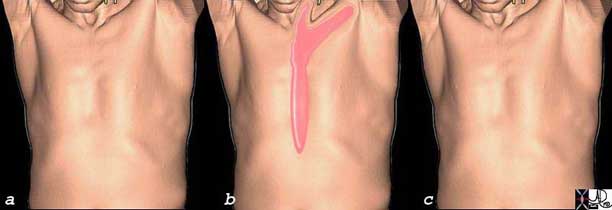
a) No pain – exercise b) Pain Pressure Typical Distribution c) Relieved by rest, TNG (nitroglycerine)
Angina is characteristically a dull, pressure-like pain, that is precipitated by stress usually after a predictable distance of a walk or run for example. In angina, the patient has no discomfort, develops pain after a fixed distance, and then stops.
Courtesy of: Ashley Davidoff, M.D.
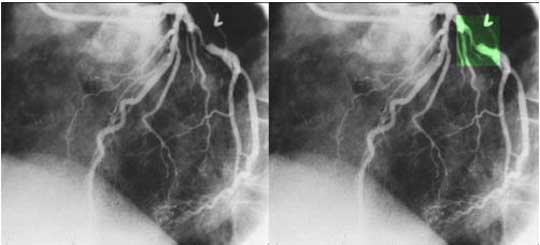
The coronary angiogram in the LAO projection shows a severe proximal stenosis (> 70%) of the circumflex with some post stenotic dilatation. The second image has a green overlay indicating the region of disease with the post stenotic dilatation. This lesion is considered hemodynamically significant.
Courtesy: Ashley Davidoff, M.D.
Cardiovascular Causes of Chest Pain: Acute Coronary Syndrome
When the pain appears to be of cardiac origin, and reflects a more serious nature in that it lasts longer than 20 minutes, is not relieved by rest or nitroglycerine, then an entity called acute coronary syndrome is entertained.
The pain of acute myocardial infarction may be very similar to the pain of angina in its character and distribution but it is not relieved by rest or nitroglycerine. It usually arises spontaneously, but may be brought on after eating a large meal or going out into the cold. It is relentless, ongoing, often accompanied with the “angor animi” sense of doom. It may be more severe than angina, but not necessarily. Associated symptoms include nausea, diaphoresis, palpitations or shortness-of-breath.
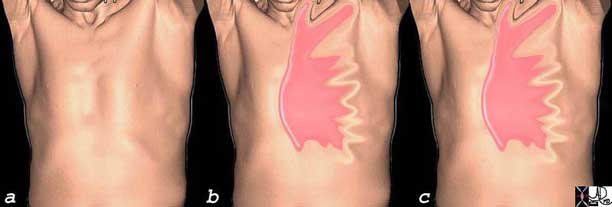
(a ) Prior to the event, (b) Sudden Severe Pain Pressure Discomfort (c) Unrelieved by TNG (nitroglycerine) and Rest and 1 hour later
In the diagram above, image (a) represents the patient without pain before the event; images (b) shows sudden and evolving chest discomfort or pressure with radiation to the neck and left arm which as shown in (c) is not relieved with nitroglycerine and remains for longer than 20 minutes, suggesting an acute coronary syndrome.
Courtesy of: Ashley Davidoff, M.D.
Acute coronary syndrome (ACS) is the term used to describe any one of the three following entities:
-
- unstable angina
- non-ST elevation myocardial infarction (non Q wave MI)
- ST elevation myocardial infarction (Q wave MI)
Myocardial ischemia is the pathophysiological substrate for all the entities above, encompassed by the term acute coronary syndrome. Myocardial ischemia is caused by an imbalance between myocardial oxygen demand and supply secondary to coronary stenosis, obstruction, thrombosis or spasm. The chest pain in an acute coronary syndrome is caused by ischemia.
Cardiovascular Causes of Chest Pain: Unstable Angina
Unstable angina (UA) is the clinical presentation of acute myocardial ischemia characterized by new onset chest pain within one month, chest pain at rest, chest pain lasting more than 20 minutes and not improving with nitroglycerin or chest pain more severe, more frequent and lasting longer than previously, without evidence of myocardial necrosis (no elevation of cardiac enzymes) and with or without EKG changes of ischemia. Unstable angina is a clinical diagnosis.
Cardiovascular Causes of Chest Pain: Myocardial Infarction
Myocardial infarction (MI) is a circulatory disorder that is characterized by the necrosis of myocardial tissue caused by myocardial ischemia, and clinically characterized by the presence of symptoms of acute myocardial ischemia (ischemic chest pain or chest pain equivalent as dyspnea, diaphoresis, lightheadedness, palpitations), associated with characteristic EKG changes and biochemical markers of myocardial necrosis as reflected by typical rise and fall of cardiac enzymes: troponin I or T, CK-MB. Pathological diagnosis of myocardial infarction requires evidence of myocyte cell death (i.e. necrosis of the myocardium) as a consequence of prolonged ischemia.
An alternate approach to classifying these entities is based on the EKG, depending on the presence of elevation of the ST segment.
Cardiovascular Causes of Chest Pain: Non ST Elevation vs. ST Elevation
Non ST elevation:
-
- Unstable angina (UA)
- Myocardial infarction (NSTEMI)
The incidence of finding thrombus in the coronary arteries in these patients is between 35-70%.
ST elevation:
-
- ST elevation myocardial infarction (STEMI)
The incidence of finding thrombus in the coronary arteries in these patients is about 90%.
The diagnosis and classification therefore rest on the character of the EKG changes and biochemical markers of myocardial necrosis as reflected by typical rise and fall of cardiac enzymes: troponin I or T, CK-MB and classified as ST elevation (STEMI) or non ST elevation myocardial infarction (NSTEMI) based on the EKG.
ST Elevation in Anterior Myocardial Infarction
This 12 lead EKG shows ST segment elevation in leads V1 – V4 (blue) indicating a ST segment elevation myocardial infarction (STEMI).The pathological diagnosis of myocardial infarction requires evidence of myocyte cell death (i.e. necrosis of the myocardium) as a consequence of prolonged ischemia (Luepker).
Treatment depends on the type of infarction (STEMI vs. NSTEMI), but attempts are usually made to lyse thrombus and open the vessels by angioplasty or stenting in a timely manner in order to salvage myocardium at risk.
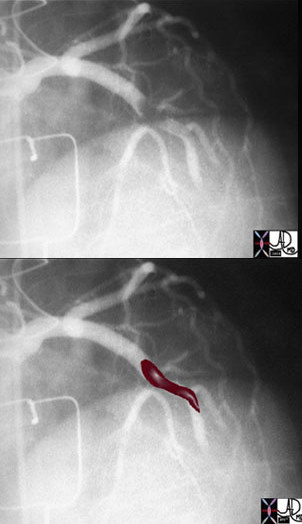
The above image of this cardiac catheterization shows a coned down left anterior oblique (LAO) projection of the LAD in a patient with acute thrombosis of the left anterior descending artery. In the lower image, the thrombus in the artery is overlaid in maroon.
Ashley DAvidoff MD
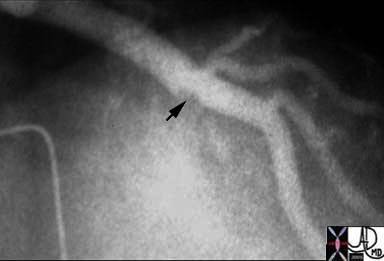
Following thrombolysis, minimal irregularity (black arrow) of the endothelium is seen. This may be residual thrombus or the remnants of a plaque rupture.
Ashley Davidoff, M.D.
Atypical characteristics of the pain make the pain less likely to be secondary to myocardial ischemia or injury. Per the AHA/ACC guidelines, the pain is considered atypical if it is pleuritic in nature, if the primary or sole discomfort of pain is in the middle or lower abdominal region, if it can be localized with one finger, if it is reproduced with movement or palpation of the chest wall or arms, if it persists for hours or if it is very brief and lasts seconds. An atypical presentation of pain makes cardiac ischemia less likely, however, not impossible as the cause of pain. Certain groups of patients such as women, diabetic and elderly persons notoriously present with atypical manifestation of myocardial ischemia.
Cardiovascular Causes of Chest Pain: Pericarditis
The pain of acute pericarditis can also be quite typical. Characteristically, the pain tends to be aggravated by movement. It is usually central, pleuritic chest pain that, as a result of the pathway of the phrenic nerves, can radiate to one or both trapezius ridges. The pain may be aggravated by breathing, simulating pleuritic pain or when the patient lies down. Pain may worsen when patients lie down and may improve when they sit up and lean forward.
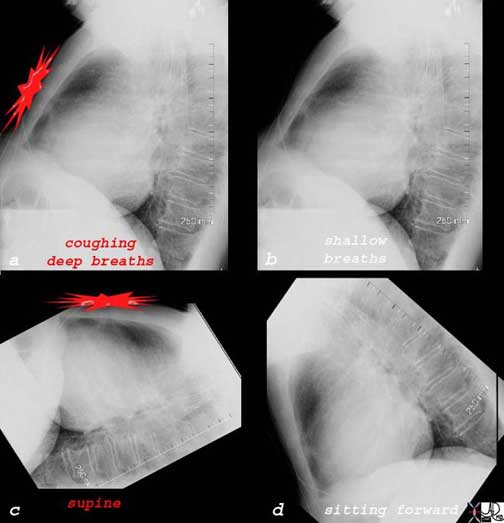
The pain of acute pericarditis can also be quite typical. Characteristically, the pain tends to be aggravated by movement. It is usually central, pleuritic chest pain that, as a result of the pathway of the phrenic nerves, can radiate to one or both trapezius ridges. The pain may be aggravated by breathing, simulating pleuritic pain or when the patient lies down. Pain may worsen when patients lie down and may improve when they sit up and lean forward.
Pericarditis_F.jpg
Aggravating and Relieving Characteristics of Pain from Pericarditis
The most characteristic feature of the pain of pericarditis is that it is relieved by sitting up or forward. Image (a) shows the characteristic sharp pain occurring in the precordium as being intense and pleuritic in nature, aggravated, by coughing and deep breathing but relieved by sitting up and shallow breathing (b). The pain is also aggravated by lying down (c), but is relieved by sitting forward (d).
Courtesy of: Ashley Davidoff, M.D.
Pericarditis is an inflammatory or infectious disorder of the pericardium and has a multitude of causes. It is commonly encountered in patients inflicted with autoimmune diseases such as rheumatoid arthritis or lupus, patients with uremia and patients who have undergone cardiac surgery. Pericarditis may also result from a viral, bacterial or fungal infection.
Patients presenting with bacterial pericarditis tend to be very sick and usually present with fever and sepsis rather than isolated chest pain. Myocardial ischemia or infarction can result in inflammation of the pericardium either acutely, or a few weeks after the acute event. Dressler?s syndrome is a specific immune syndrome consisting of fever and pericarditis occurring weeks after a myocardial infarction. The incidence of ischemia or infarct related pericarditis has declined since the advent of early coronary revascularization and the use of thrombolytics.
Cardiovascular Causes of Chest Pain: Acute Pericarditis
Acute pericarditis results in a serositis so that the inflamed pericardium presents with a somatic pain, and also exudes fluid into the pericardial space. Acute pericarditis can be complicated by pericardial tamponade if there is a rapid accumulation of pericardial fluid.
The clinical presentation includes central, pleuritic chest pain described above. On auscultation of the heart, a monophasic, biphasic or triphasic pericardial rub can be appreciated. Pericardial rubs are highly specific for pericarditis; however, require careful or skillful auscultation to be picked up. Their low sensitivity is also due to their fleeting or intermittent nature.
The diagnosis is suspected by the classical clinical presentation, and larger pericardial effusions may cause decreased EKG voltages. However, the diagnosis is best confirmed with echocardiography.
Treatment includes anti-inflammatory drugs such as aspirin, NSAID or prednisone. Aspirin is effective, however, the mostly utilized treatment for pericarditis is ibuprofen. It can be combined with colchicine that can help prevent recurrent episodes of pericarditis. The combination therapy should last 7 to 14 days and is then tapered over a week or two to prevent recurrence. Oral prednisone is used in patients with severe pericarditis and who do not respond to NSAIDs.
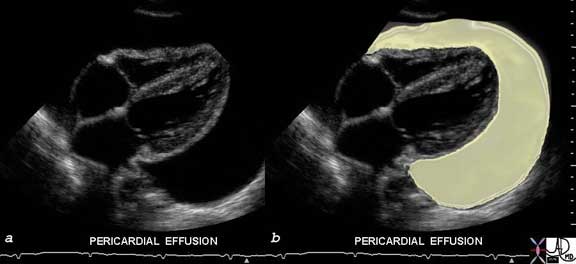
The study of choice for the patient with pericarditis is echocardiography, since both the pericardium and myocardium can be evaluated. It is not uncommon for there to be an associated myocarditis that requires evaluation and echo can evaluate both issues. When the pericardial effusion becomes large, it sometimes relieves the pain but it brings other issues as the potential for tamponade. This is also assessed using the echo combined with new clinical symptoms of cardio respiratory difficulty.
Courtesy of: Philips Medical Systems
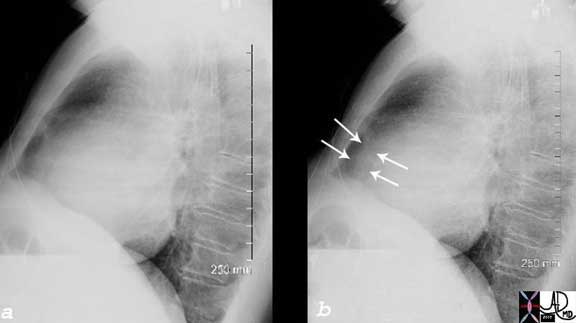
The chest x-ray is not a sensitive test for pericardial effusion but since it may be the first imaging test in the patient with chest pains, it is important to recognize pericardial effusion as seen on the lateral examination (arrows). On the frontal examination, the shape of the cardiac silhouette is said to look like a water bottle.
Courtesy of: Ashley Davidoff, M.D.
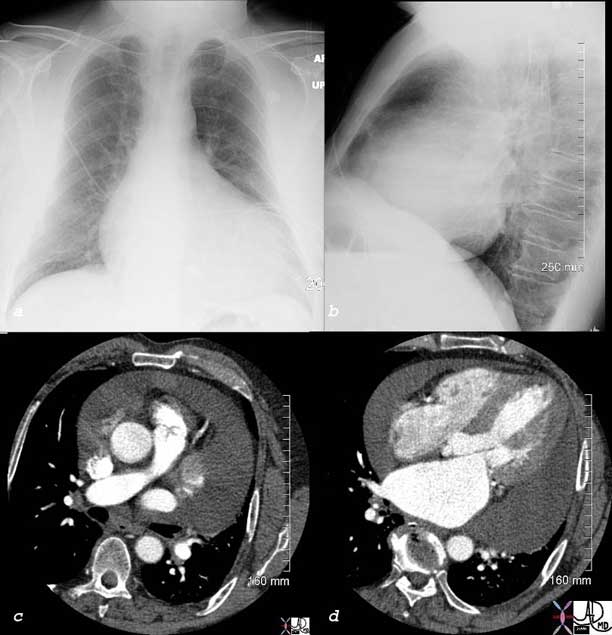
The chest x-ray is not a sensitive test for pericardial effusion but since it may be the first imaging test in the patient with chest pains, it is important to recognize pericardial effusion as seen on the lateral examination (arrows). On the frontal examination, the shape of the cardiac silhouette is said to look like a water bottle.
Courtesy of: Ashley Davidoff, M.D.
Aortic Dissection
Aortic dissection is a sudden catastrophic disruption of the aortic wall caused by a shearing tear of the intima, and secondary involvement of the media by the advancing dissection and hematoma. The event characterized by a splitting of the arterial wall along the longitudinal plane of the aorta.
The pain of aortic dissection is dramatic. It is classically hyperacute, sudden, severe, lancinating, excruciating, tearing, stabbing, throbbing, reaching its maximum intensity at the moment of onset. On the other hand, some patients may present with minimal or no symptoms. The duration of the pain is not measured in minutes and may simulate the pain of myocardial infarction. The pain may be felt in the anterior chest, the neck, and/or the back, sometimes reflecting the location of the dissection with ascending dissections noted with anterior chest pain, arch dissections with neck pain and descending thoracic dissections noted with interscapular or back pain. Since dissections may involve the coronary arteries, and more commonly the right, myocardial ischemic pain may be present as well.
It is historically interesting to note that in 1910 William Osler recognized that “spontaneous tear of the arterial coats is associated with atrocious pain, with symptoms, indeed, in the case of the aorta of angina pectoris and many instances have been mistaken for it”.
The pain is caused by the stretching of the aortic wall, and hence its potential to have a throbbing character. It is not aggravated by position or body movement, nor relieved other than by analgesia, tincture of time, or repair.
The impending sense of doom originally described as “angor animi” literally means anguish of the soul may accompany the pain. This sensation sometimes accompanies other life-threatening situations when there is massive outpouring of catecholamines, such as myocardial infarction and pulmonary embolism.
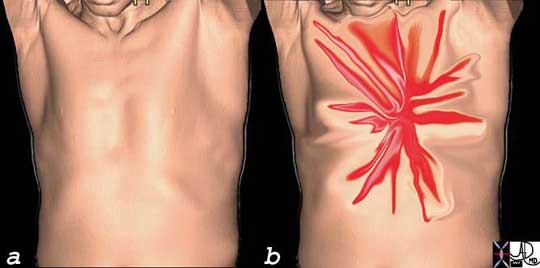
This image is intended to reflect the severe (bright red) lancinating, sharp, thunderbolt-like character (spiculated shape) of the chest pain that the patient with acute dissection may experience. One moment the patient is healthy without symptoms (a) and the next, there is catastrophic pain that reaches maximum intensity at the time of onset (b). This is one of the pain syndromes in medicine one fears. It represents one of the most severe forms of chest pain one can experience.
Courtesy of: Ashley Davidoff, M.D.
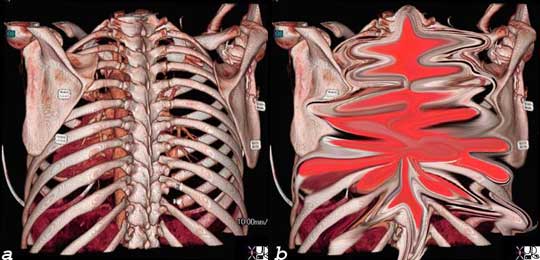
The pain of dissection may be felt either in the front of the chest and/or the back. Either way, the pain can have similar characteristics – i.e. sharp, thunderbolt-like, severe, and rapidly and almost instantaneously reaching maximum intensity coincident with the onset.
Courtesy of: Ashley Davidoff, M.D.
Typically, aortic dissection occurs in patients with uncontrolled hypertension, pregnancy, atherosclerosis and diseases such as Ehlers-Danlos and Marfan. Asymmetric blood pressure or pulses or a new diastolic murmur due to aortic regurgitation may be appreciated on the examination of the patient. Aortic dissection represents a medical emergency.
Clinically, the pain syndrome may be classical and the finding of unequal pressures or the association of complications such as stroke, Horner?s syndrome, hoarseness, new onset aortic regurgitation or pericardial hemorrhage may help make the diagnosis. The study of choice to confirm the diagnosis and assess severity is CT scan, both without and with contrast, which is able to confirm the diagnosis and evaluate the extent of the disease.
The treatment depends on the extent of the dissection. Patients with an ascending aortic dissection require urgent surgery, while patients with descending aortic dissection are managed medically. Such patients require optimal control of their blood pressure to limit the extent of the dissection.
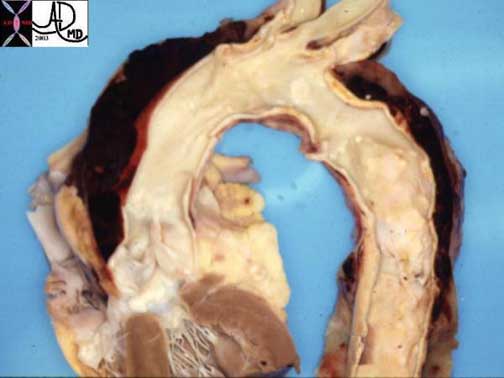
This pathological specimen shows an aortic dissection starting at the root of the aorta and extending across the arch and into the descending portion. The false lumen is filled with clotted blood.
Courtesy of: Henri Cuenoud, M.D.
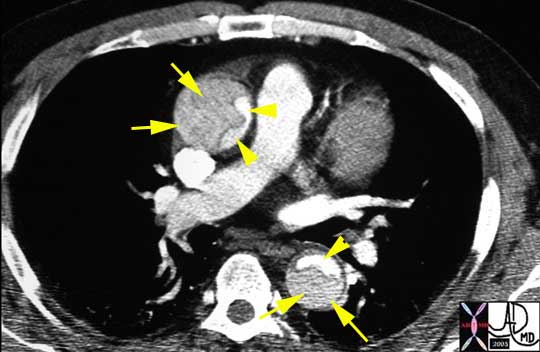
The CT image shows a dissection in the ascending aorta. The lumen consists of the smaller true lumen (with white contrast) and the false lumen (larger with grayer density). The involvement of the ascending aorta makes it a type A dissection and therefore, treatment requires surgical repair. In this patient, however, the dissection extended to the descending aorta as well. Either way a type A dissection requires surgery.
Courtesy of: Ashley Davidoff, M.D.
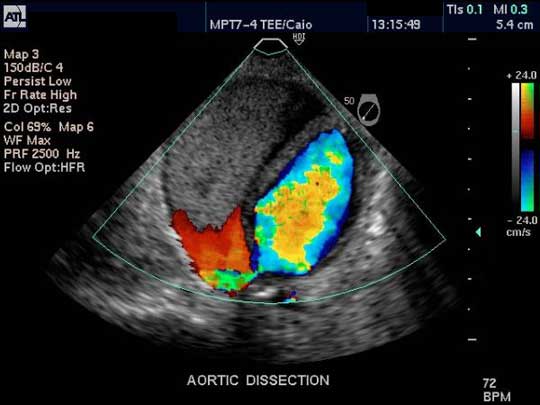
The transesophageal echo using Doppler Ultrasound (US) of the descending thoracic aorta shows flow in the true lumen (color) and no flow in the thrombosed lumen (gray echoes) in this patient with aortic dissection.
Courtesy of: Philips Medical Systems
Acute Aortic Syndrome
Acute aortic syndrome (AAS) is a complication of atherosclerotic disease of the aorta that is characterized by a classical clinical presentation of sudden acute searing pain in the chest or back, usually in a hypertensive patient. Since the pathogenesis of this disease results in acute distension of the aortic wall, its pain characteristics simulate acute aortic dissection. Hence, the same dramatic pain characteristics that occur in dissection apply to acute aortic syndrome, characterized by a sudden acute, severe, shearing or lancinating pain that reaches maximum intensity at onset. Similarly though as well, the symptoms may be minimal or absent.
The clinical features and pathology of the two entities can be quite different. Whereas dissection is usually in a younger age group, acute aortic syndrome is seen in the older atherosclerotic age group and is more commonly associated with hypertension. Classic aortic dissection is characterized by the presence of intimal tear that usually progresses to the media and then rapidly dissects for quite a distance (sometimes the entire aorta) and will usually have a reentrance site. Intramural hematoma is characterized by the presence of severe atherosclerotic plaque, with acute hemorrhage into the aortic media which may remain as a hematoma in the media or may progress to a dissection. The dissection though is usually limited because the atherosclerosis and inflammatory changes and fibrosis present in the wall prevents an easy route for progression. The re-entrance of the dissection in AAS is usually absent and hence, thrombosis of the focal dissection results.
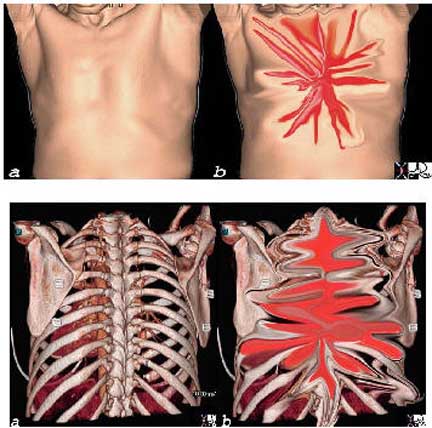
Searing Chest or Back Pain of Acute Aortic Syndrome
Courtesy of: Ashley Davidoff, M.D.
The cause of AAS is an acute mural hematoma. This may result from a hematoma into a plaque, into a penetrating ulcer, or a hematoma in a focal dissection. The space occupation and sudden distension associated with the disease process by one of these disorders results in the classical pain syndrome. The disorders are best diagnosed by using a combination of non-contrast CT, combined with a contrast-enhancing CT.
The hematoma in the wall may be complicated by a classical dissection, where the tear in the wall extends along the longitudinal plane. Aortic rupture can occur as well.

The lumen of the aorta with blood is demonstrated in red. The intima of the wall is the thin light pink layer just under the red luminal layer. The media or elastic layer is in teal, while the outer layer is a light yellow color (a). This diagram illustrates the progression from an ulcerated plaque (a), to a mural hematoma (b). The ulcer in (c) has penetrated into the media itself and is called a penetrating ulcer with a mural hematoma. In (d), a small focal dissection with flowing blood is seen, and this can either thrombose or progress to a full dissection(e) or penetrate through the wall and be contained (e) or eventually rupture into the mediastinum (f).
a = aortic ulcer indicating severe atherosclerosis ? not associated with pain
b = acute mural hematoma
c = acute mural hematoma large
d = focal dissection
e = penetrating ulcer
f = rupture
Courtesy of: Ashley Davidoff, M.D.
Treatment is based on the size, position and nature of the lesion, as well as comorbid conditions and thus, would be either surgical or medical.

This CT scan through the upper chest shows ulcerations in the aorta (bright red) with a cap (maroon) overlying the larger ulcer. In acute aortic syndrome it is the hemorrhagic rupture of the plaque and the distention of the aortic wall that causes the pain.
Courtesy of: Ashley Davidoff, M.D.
Pulmonary Embolism
The pain of pulmonary embolism is also fairly dramatic but is most commonly pleuritic in nature meaning it is somatic, sharp, aggravated by deep inspiration and coughing and relieved somewhat at expiration. It results from pleural involvement from a distal, pulmonary infarction. However, patients with massive pulmonary emboli involving the larger and central vessels can present with substernal chest pain as a result of vessel distension. Patients with massive pulmonary emboli may also present with respiratory distress, hypotension and failure of the right ventricle, secondary to a sudden increase in the right ventricles afterload. The impending sense of doom originally described as “angor animi” (anguish of the soul as described above) may accompany the pain of pulmonary embolism particularly if the pulmonary embolus is large and/or there is a massive outpouring of catecholamines.
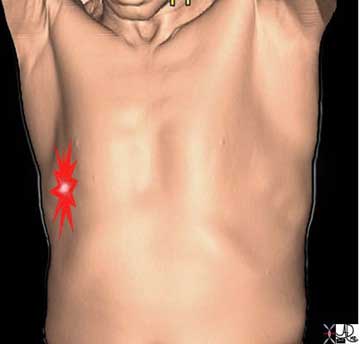
The pleuritic pain demonstrated on the right side of this patient is characterized by focal intense (bright red) and sharp pain that is aggravated by deep breaths and by coughing. The location corresponds to the disease and to the images described below.
Ashley Davidoff, M.D.
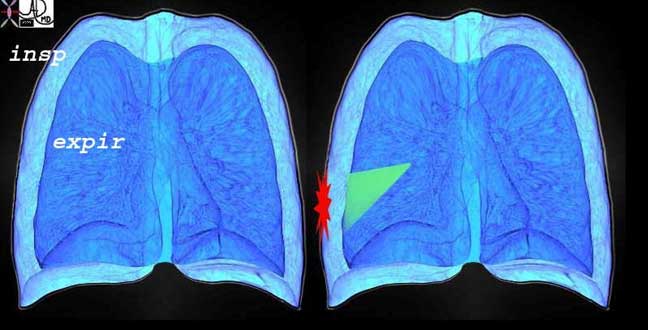
This diagram re-enforces the concept of the pleuritic pain being related to respiratory movements and is focal and overlying the disease process. The outer part of the diagram represents the expanded lung of inspiration and the inner less voluminous lung represents the deflated lung of expiration. The green wedge represents the infarcted area of lung from the pulmonary embolus that abuts and involves the visceral and parietal pleura.
Ashley Davidoff, M.D.
Pulmonary thromboembolism (PE) is a circulatory disorder of the pulmonary arteries characterized by embolic occlusion of one or more pulmonary arteries by bland thrombus.
Thrombotic PE is a leading cause of morbidity and mortality particularly among hospitalized patients. Most commonly, the thrombi originate from the deep venous system of the lower extremities. Less common sources include pelvic veins, upper extremity veins, right heart chambers and in situ thrombosis. The causes for the deep venous thrombosis are crystallized by Virchow’s triad; venostasis , endothelial injury, and hypercoagulability. Patients immobilized for long periods (prolonged flights, prolonged bed rest) are predisposed because of stasis. Hypercoagulable states are sometimes inherited and are sometimes part of malignant conditions.
Acute thrombus in the veins is minimally adherent to the wall of the vessel and hence the propensity to embolize to the right heart and then to the lungs resulting in a variable degree of occlusion of the pulmonary circulation. In general, the larger the thrombus load, the greater the clinical consequence.
Clinically, the presentation ranges from asymptomatic to sudden death. A variety of pulmonary symptoms include dyspnea, pleuritic chest pain, tachypnea, cough and anxiety; while clinical examination may reveal non specific rales, tachycardia, or low grade fever.
The diagnosis is based on high clinical suspicion by the “clot conscious” caregiver, usually in the presence of lowered oxygen saturations and increase in the alveolar-arterial gradient. Visualization of thrombus in the pulmonary circulation using CT angiography is the gold standard, however.
Treatment is usually by anticoagulation and in a selected few where the thrombus load is life-threatening, thrombolysis or thrombectomy is considered.
Wedge-Shaped Defect on CXR
The plain film of a patient with right-sided pleuritic pain and hypoxemia is shown. Image (a) shows a vague wedged-shaped defect in the right lower lobe [overlaid in red in (b), enlarged in (c) and (d)]. This wedge shaped-peripheral based defect is known as Hampton’s hump and is suggestive of a pulmonary infarction, and subsequently proven by CT scan. When a pulmonary embolism causes an infarction, it may be seen as a wedged-shaped defect on the chest x-ray. However, it is not a very common event since the lung has three sources of oxygen: pulmonary artery, bronchial artery and directly from the inspired air to the alveoli Since the pulmonary circulation of the lung is an end arterial circulation, the most distal portion of the segment of the lung and its pleura will be affected when infarction does occur. The accompanying inflammatory process will involve the pleura and pleuritic pain ensues..
Ashley Davidoff, M.D.
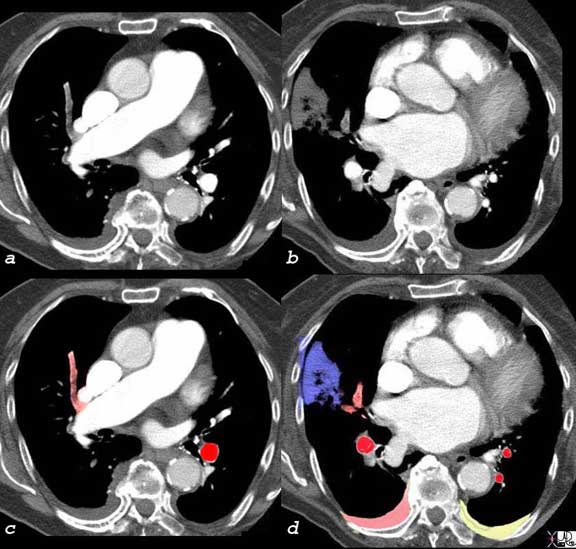
The CT scan of this patient shows an occlusive embolus (gray in (a) and overlaid in pale red in (c), as well as the branches of this vessel (gray in (b) and overlaid in pale red in (d), resulting in a peripheral pleural-based infarction (gray in (b) and overlaid in blue in (d). There are bilateral effusions with right effusion (pink overlay) likely to be hemorrhagic and the left effusion likely to be transudative. Pulmonary infarction as seen in this case, is not common since the lung receives oxygen directly from the alveoli, as well as from the bronchial arterial circulation. However in this patient, there was associated congestive heart failure and perfusion and ventilation were reduced at baseline. When one adds insult to injury with a PE, compensatory mechanisms are not available and infarction ensues.
Images courtesy of: Ashley Davidoff, M.D.
Pneumonia
Patients with pneumonia can also present with chest pain, classically due to involvement of the pleural surface with the inflammatory process. Thus the pain would be similar to that described above with pleuritic PE pain, somatic and sharp, aggravated by deep inspiration and coughing and lessened by shallow breathing. Patients usually present with shortness-of-breath, a productive cough, and fever as well.
An infection of the trachea or bronchi, tracheobronchitis, may present with sternal chest pain in a patient. Pneumonia can be caused by a virus or bacteria. The patient may also experience some discomfort in breathing and a cough that can worsen the pain.

The pleuritic pain of pulmonary embolism, pneumonia or pleurisy is not distinct in itself, but the associated findings relating to the specific disease will help differentiate the variety of causes of pleuritic chest pain.
In this instance, a peripheral-based pneumonia abuts the pleural surface and parapneumonic pleural inflammation involves both the visceral pleura and the parietal pleura. When the lung moves with respiration, the rubbing of inflamed structures and particularly the pleura brings about the sharp focal pleuritic pain localized over the pneumonia.

The AP and lateral CXR shows right upper lobe pneumonia actually localized to the right upper lobe on the PA view (a), while on the lateral view it appears that the posterior segment of the right upper lobe is involved. In this patient the pleuritic pain may be felt in the back.
Images courtesy of: Ashley Davidoff, M.D.
Pneumothorax
Accumulation of air in the pleural space leading to collapse of the underlying lung can occur spontaneously in tall and slim, young adults or in patients with a history of emphysema. Such patients usually present with an acute onset of unilateral pleuritic pain that may be associated with dyspnea. Depending on the size of the pneumothorax, it can be managed conservatively by observation or by evacuation of the air through placement of a chest tube.
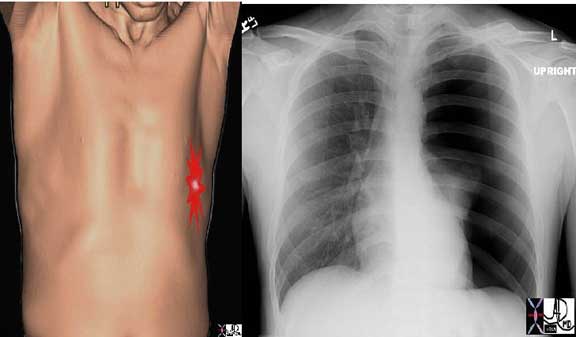
This is the type of CXR that sends shivers down the spine. The overall blackness of the left chest cavity, in association with a nubbin of lung tissue in the ipsilateral hilum and rightward mediastinal shift is characteristic of a tension pneumothorax with total atelectasis of the left lung. Immediate and urgent decompression with a chest drain is indicated. One must also remember that if a tall, thin, young patient presents with chest pain the diagnosis of dissecting aneurysm in a patient with Marfan?s Syndrome has to be considered.
Courtesy of: Ashley Davidoff, M.D.
Pleurisy
Pleurisy is an inflammatory disorder of the pleura, having a multitude of causes but resulting in pleuritic pain and pleural effusion.
The pain, as stated, is usually pleuritic but can be dull, burning, sharp or stabbing. It is relatively acute in onset and can be quite severe (6 – 7/10). It is aggravated by coughing and deep breaths and may be relieved by shallow breaths and lying with the affected side down because chest wall motion is limited. Anti-inflammatory medications may relieve the pain. Associated symptoms may include fever, cough, or productive cough.
The diagnosis is suspected clinically by the history and dullness to percussion; whispering pectoriloquy reflects an effusion. A pleural friction rub may be heard.
The chest x-ray helps in making the diagnosis of a pleural effusion and in the appropriate clinical setting will confirm the clinical suspicion. Rib films, if a fracture is suspected, are indicated.
Treatment is directed to the cause but symptomatic treatment includes ibuprofen, indomethacin or naproxen.
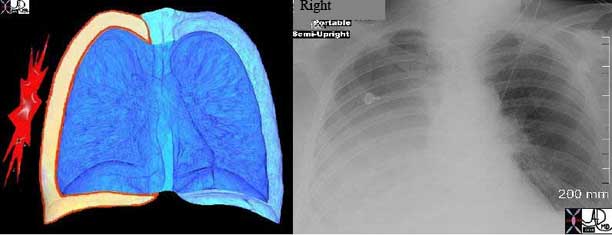
The pleuritic pain is sharp, severe, and aggravated by deep breathing and coughing and relieved by shallow breathing and lying ipsilateral side down. The image on the right shows an overall increase in density of the right chest suggestive of a pleural effusion which is non-specific and may accompany many of the diseases discussed.
Courtesy of: Ashley Davidoff, M.D.
Pulmonary Hypertension
Patients with pulmonary hypertension may be inflicted with chest pain that is thought to be secondary to underlying right ventricular hypertrophy and ischemia.
Pulmonary hypertension is circulatory, characterized by an abnormally high pressure in the pulmonary arteries. The diagnosis is defined as a systolic pressure that is greater than 30 mmhg or a mean pressure that is greater than 20 mmhg.
There are many causes for the disorder including: left heart failure, mitral valve disease, chronic lung disease, (cor pulmonale) and congenital left-to-right shunts. Patients with chronic thromboembolic disease may have hypertension and acute embolic disease may be associated with acute hypertension. When the cause is known it is called secondary hypertension. In many the cause is unknown in which case it is called primary pulmonary hypertension. In some cases there is a genetic predisposition.
Clinically, the entity results and manifests in shortness-of-breath, coughing, wheezing, chest pain, fatigue, fainting, dizziness, lightheadedness, and swelling in the legs. The diagnosis is confirmed by identifying an enlarged right ventricle, abnormally loud P2 sound, a systolic ejection murmur, and perhaps a pulmonary diastolic murmur, by electrocardiography which shows right ventricular hypertrophy. Echocardiography can not only evaluate right ventricular and right atrial size, but also can accurately estimate the pulmonary arterial pressure if there is tricuspid regurgitation. While the CXR, CT scan and MRI can evaluate pulmonary arterial size and right ventricular size, the most accurate evaluation of the entity is via cardiac catheterization which measures the pressures directly.
Treatment is directed to the cause when known, usually with medication and oxygen. In patients with underlying mechanical causes such as left-to-right shunts, a surgical option is possible if the fixed component of the hypertension is not excessive.

This unfortunate 32 year-old-female with scleroderma has many causes for chest pain but the cause under discussion is a relatively uncommon cause for chest pain – pulmonary hypertension. This is best diagnosed with echocardiogram or cardiac catheterization but in this CT (b) and (c) the large pulmonary artery (blue – which should be the same size of the red aorta normally) is indicative of pulmonary hypertension. Her heart is enlarged as is seen on the chest x-ray (a) and on the CT (d). She has a pericardial effusion, and bilateral pleural effusions (d) both of which can cause pain. In addition, she has an enlarged patulous esophagus (seen as a black slit behind the heart (d) characteristic of scleroderma, and associated with reflux which is another cause for chest pain.
Courtesy of: Ashley Davidoff, M.D.
Gastrointestinal Causes of Chest Pain
Gastrointestinal pathologies are a leading cause of non-cardiac chest pain. Gastroesophageal reflux can cause pain as a result of gastroesophageal distension, inflammation, or spasm induced by the reflux. The pain, therefore, can have multiple clinical presentations that range from discomfort, squeezing, pressure, dull pain, and burning pain to pain that mimics angina or myocardial infarction. Esophageal spasm, for example, may also respond to nitroglycerine which becomes clinically a challenging situation. Esophageal irritation by the highly acidic gastric secretions due to gastroesophageal reflux can cause a burning retrosternal pain which characteristically is relieved by antacids and proton pump inhibitors.
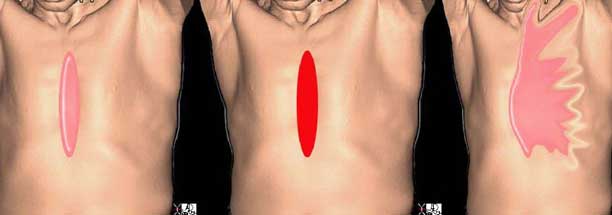
Gastroesophageal reflux disease (GERD), with or without esophagitis and spasm can often masquerade as cardiac pain varying from substernal discomfort, and pressure-like symptoms, to substernal pain and burning (b) to discomfort that radiates to the neck and shoulder (c) but also is sometimes relieved by nitroglycerine. The pain, however, is not precipitated by exercise, nor relieved by rest. Courtesy of: Ashley Davidoff, M.D.
Gastroesophageal reflux disease (GERD) is a common mechanical disorder of the lower esophageal sphincter that is caused by multiple factors including obesity, transient relaxation of the lower esophageal sphincter and hiatus hernia. It is exacerbated by the consumption of a lipid-rich meal, caffeine, mint and chocolate and patients should avoid heavy meals at night. An elevated abdominal pressure seen in gravid or obese patients can also lead to gastroesophageal reflux.
The reflux of acidic gastric contents onto the esophageal mucosa results in distension of the esophagus and inflammatory changes commonly complicated by erosive esophagitis. Such patients may also experience esophageal spasm that produces a squeezing retrosternal pain that can be difficult to clinically differentiate from a myocardial cause of pain. It can also be relieved with nitrates.
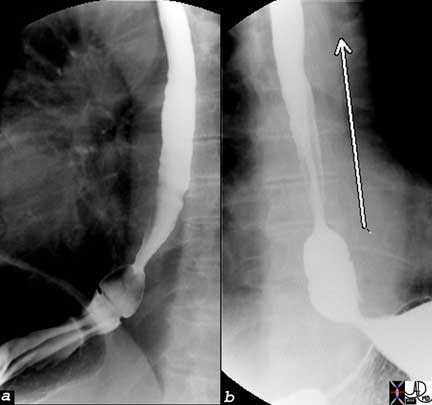
The images are from a barium swallow showing a small pouch-like hiatus hernia above the diaphragm in (a) and gastroesophageal reflux indicated by the arrow in (b). Courtesy of: Ashley Davidoff, M.D.
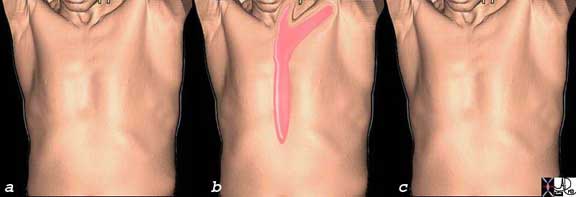
The diagram illustrates a patient without pain (a) who develops substernal pain radiating to the neck and left shoulder. He takes nitroglycerine and the pain is relieved. (c) The pain was, however, not related to exercise and was not relieved by rest and lasted 10 minutes. What is the most likely cause of the pain? Sometimes esophageal spasm associated with GERD can respond to nitroglycerine and this is the most likely diagnosis. The patient, however, should undergo a stress test to ensure that he does not have ischemic heart disease. Courtesy of: Ashley Davidoff, M.D.
Up to 15% of adults in Western society report symptoms monthly or weekly, while 7% report daily symptoms.
The diagnosis is probably best made clinically. The clinical presentation varies from the classic retrosternal burning sensation to chest pain, waterbrash (hypersalivation), and halitosis. It has been suggested that up to 60% of non-cardiac chest pain can be attributed to GERD. The absence of gastroesophageal reflux in a barium swallow does not exclude the diagnosis.
The mainstay of therapy for GERD remains the Proton Pump Inhibitors (PPI) and the H2 Blockers.
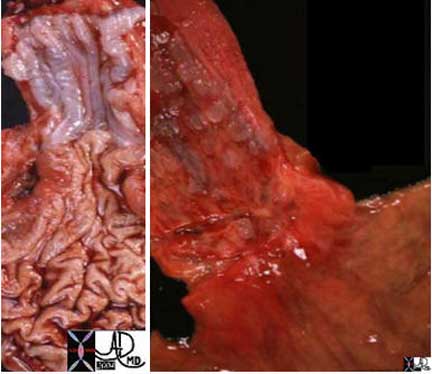
The GE junction is a distinct border as seen normally in the left image. The distal esophagus is normally a pearl white hue, while the gastric mucosa is a pink hue. In esophagitis the hyperemic inflammatory changes make the border less distinct (right image).
Courtesy of: Ashley Davidoff, M.D.
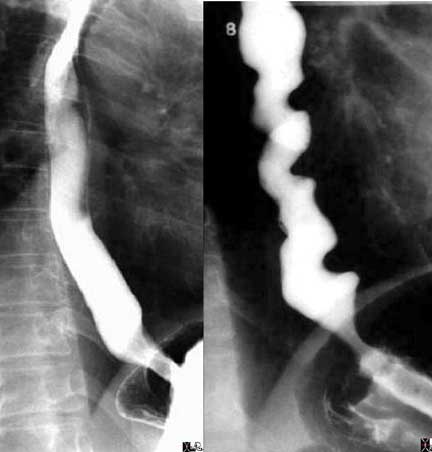
The normal gastroesophageal reflux is marked in the image on the left (surgical specimen) by the transition from the white squamous lining of the esophagus to the salmon-colored lining of the stomach. In the image on the right, a post mortem specimen, there is severe esophagitis and the normal white lining of the esophagus is replaced by inflamed red, indicating severe esophagitis. Courtesy of: Ashley Davidoff, M.D.
Back Pain
The high back pain syndromes are included in this module because diseases in the chest can present with back/chest pain and they need to be differentiated from the abdominal causes of back pain. Thus, aortic dissection, pneumonia, pleurisy and pulmonary embolism can localize to the back.
There are abdominal disorders that originate in subdiaphragmatic locations that can present with back pain including acute and chronic pancreatitis, acute cholecystitis, splenic and liver diseases. Acute pancreatitis is quite distinct and usually presents with epigastric pain that may also go to the back. The most common cause is as a result of an alcoholic binge and thus, in the young patient there are some leads to follow. In the older patient, gallstone pancreatitis could present as a diagnostic dilemma but the issue is resolved once the serum amylase and lipase is evaluated. Chronic pancreatitis and pancreatic carcinoma may present with high back pain and these usually require CT scanning to establish the correct diagnosis.
Acute cholecystitis usually presents with right upper quadrant pain but may also present as interscapular pain often with a band-like distribution between the scapula.
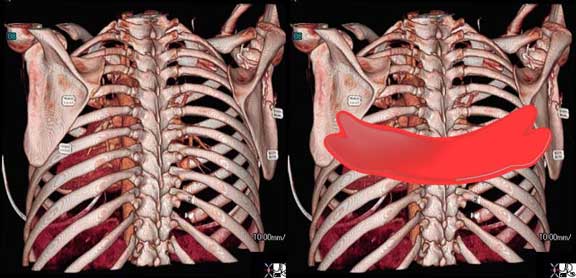
The interscapular band-like back pain is part of both lower chest and upper abdominal disease.
Courtesy of: Ashley Davidoff, M.D.
Acute pyelonephritis will present as a high back pain, will be unilateral and usually is exquisitely tender. The disease is usually diagnosed with white cells in the urine and a history of cystitis. Renal colic may also present as high back pain, but the presence of hematuria and radiation (loin to groin) pattern when present, creates specificity for the diagnosis.
Skin
The pain of herpes zoster (shingles) is quite severe and can last a month. The onset is insidious and is characterized as burning, throbbing or stabbing. It is tender to the touch and may show a rash or vesicles along the affected dermatome. Usually only one dermatome is involved but it may involve two or three dermatomes. The thoracic dermatomes are most commonly involved. Associated finding include systemic symptoms of the virus (20%) and paresthesias in the involved dermatome.
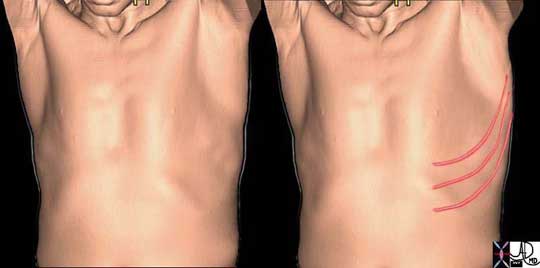
Pain that distributes along a dermatome is characteristic of herpes zoster (also known as shingles) .The dermatomes involved are usually thoracic and between one and three dermatomes are involved with burning and sometimes severe pain associated with a rash with vesicles. Courtesy of: Ashley Davidoff,
Rib Fractures
Rib fractures are a source of incapacitating pain. The somatic nature, focal over the area of injury usually is caused by involvement of the underlying periosteum and pleura and hence, the pain is pleuritic in nature, aggravated by deep breathing and coughing and relieved to some extent by shallow breathing. The most common cause is known traumatic incident but fractures may occur with coughing spells, with little precipitating cause in the osteoporotic elderly, and as stress fractures in athletes (e.g. disc throwers) from excessive and repetitive forces.
The entity is most commonly diagnosed using plain x-rays and occasionally in the osteoporotic patient, bone scan may be used to identify the cause of chest pain.

Multiple hot spots (black dots) are seen along multiple sequential posterior ribs on the right, characteristic of multiple rib fractures. The involvement of multiple ribs and their close linear and contiguous spatial relationship make trauma much more likely than metastases. Courtesy of: Alan Ashare, M.D.
Dangerous Rib Fractures
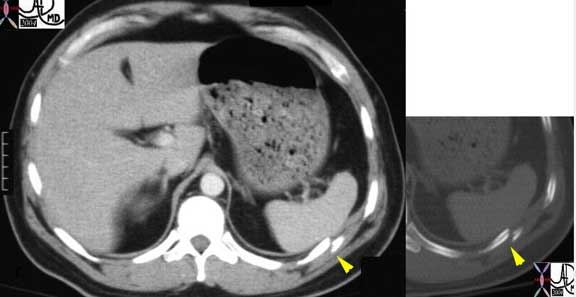
Courtesy of: Ashley Davidoff, M.D.
Costochondritis
Costochondritis is due to the inflammation of the costochondral or costosternal joints and can cause anterior chest pain in young adults and elderly patients. The pain is usually described as sharp and can be brief, intermittent or persistent and dull. The pain is usually well-localized, involves more than one junction in most patients and can be pointed out by the patient with one digit. Sometimes the patient is not aware of the pain but minimal compression of the rib cage from the lateral force results in a characteristic localization of the pain at the costochondral junction. It is a benign cause of chest pain. Patients should be reassured prior to discharge.
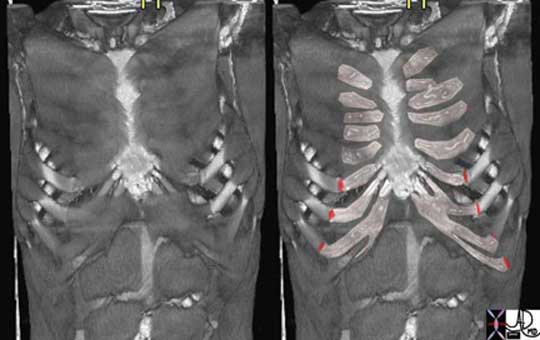
The location of the pain in patients with costochondritis is very characteristic in its location along the costochondral junctions as outlined in the above coronal 3D reconstruction of a CT scan (red).
Ashley Davidoff, M.D.
Other disorders of the ribs and sternum such as osteomyelitis and metastases are usually quite focal, somatic in character and not usually confused with acutely life-threatening conditions.
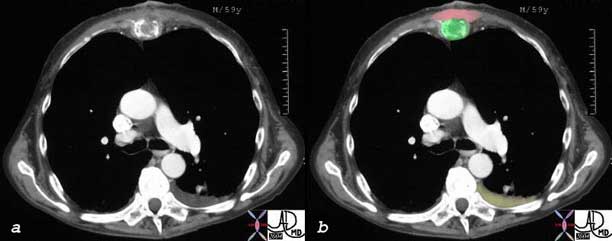
The sternum noted anteriorly in this axial CT section through the chest shows an expanded and destroyed sternum (green) with swelling in the soft tissues anterior to the sternum (pink). A left-sided chest effusion (yellow) is noted incidentally.
Images courtesy of: Ashley Davidoff, M.D.
Muscular Causes
Muscular aches and strains from exercises are quite common but usually there are known precipitating causes such as recent exercise. Myositis from viral disease is usually a dull pain involving other muscles and is associated by other systemic symptoms of the illness.

The 3D image reconstructed from the raw CT data shows the musculature of the anterior chest wall and the recti of the abdominal muscles. There are many muscles in the anterior and posterior chest wall that could become inflamed or strained.
Ashley Davidoff, M.D.
There are some unusual causes of myositis including polymyositis and dermatomyositis which are also part of a systemic illness. Infected myositis, secondary to osteomyelitis, may also cause chest pain.
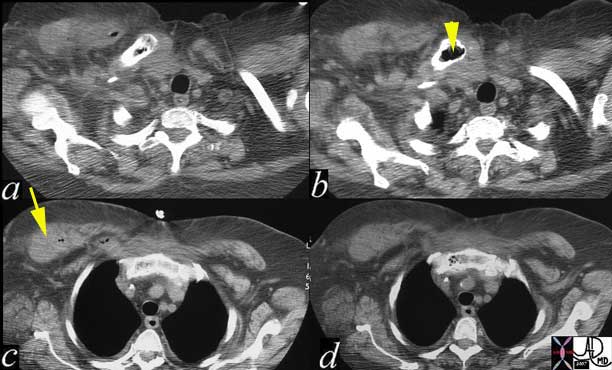
This unusual case of an osteomyelitis (air in clavicle noted with yellow arrowhead) and (b), (air in sternum image (d) together with a swollen right-sided pectoralis major (yellow arrow) that also contains air (a) and (c) was caused by clostridium welchii.
Images courtesy of: Ashley Davidoff, M.D.
Clinical Approach
The initial approach to a patient with chest pain is directed towards two goals: to determine a diagnosis and to ensure the safety of the patient throughout the process. Therefore, it is crucial to first assess the patient for any sign of respiratory distress or cardiovascular compromise and stabilize the patient if needed. A focused history and physical examination should be pursued in the stable patient in the aim of screening for life-threatening conditions such as an acute myocardial infarction, aortic dissection or massive pulmonary embolism. While obtaining the history, it is important to determine the manner of onset of the pain, its character, duration and any associated symptoms.
History and Precipitating Factors
Chest pain due to myocardial ischemia or infarction is classically precipitated by physical exertion such as shoveling snow, meal consumption and cold weather. Also, any situation leading to tachycardia or increased myocardial oxygen demand in a patient with limited myocardial oxygen supply secondary to coronary atherosclerosis can lead to an imbalance between oxygen demand and supply and myocardial ischemia.
A recent history of an upper respiratory tract infection may predispose a patient to a bacterial pneumonia or to pericarditis.
Pulmonary embolism is usually seen in patients who lead a sedentary lifestyle, have recently undergone surgery, have recently traveled or who have an underlying malignancy. Patients on oral contraceptive pills are also at increased risk of developing deep venous thrombosis and pulmonary emboli. Other patients may be at increased risk of developing pulmonary emboli due to a hereditary, thrombogenic state.
Patients experiencing chest pain due to underlying gastroesophageal reflux may experience their symptoms after consuming a large, rich meal or after lying flat soon after a meal. Also, an increase in abdominal pressure secondary to either obesity or to a gravid state can lead to gastroesophageal reflux.
History and Precipitating Factors: Duration and Onset
Duration
An episode of myocardial ischemia may last between two minutes to twenty minutes and leads to infarction if it persists. If the pain lasts seconds or has persisted for days, a diagnosis other than myocardial ischemia or infarction should be entertained.
Chest pain that lasts seconds after movement is suggestive of costochondritis or another musculoskeletal cause. Chest pain secondary to pneumonia or pulmonary emboli may last days till the resolution of the underlying problem.
Onset
A sudden onset of chest pain is concerning for life-threatening conditions such as myocardial ischemia, infarction, aortic dissection or pulmonary emboli. Other more benign conditions may also present acutely such as a pneumothorax or a rib fracture. Chest pain, secondary to gastroesophageal reflux, is more gradual in onset.
History and Precipitating Factors: Character / Situation
Character
Patients experiencing myocardial ischemia or infarction usually describe their pain as a ?pressure? or discomfort rather than frank pain. They may also place a clenched fist above the sternum or to the left side of their chest to better describe their symptom.
The severe, lancinating pain of acute dissection is dramatic and mostly unmistakable.
The sense of impending doom caused by massive outpouring of catecholamines occurs with dissection, acute MI, and pulmonary embolism.
Chest pain that is due to a pulmonary pathology such as pneumonia, pneumothorax, or pulmonary infarction, secondary to a pulmonary embolism is usually pleuritic in character.
Gastroesophageal reflux may cause a retrosternal, burning sensation.
Situation
The pain of GERD and angina are usually substernal, while cardiac pain may also involve the neck, chin and arm. Pleuritic pain from pneumonia, rib fracture, PE, or pleurisy is focal and depends on the location of the disease.
High back pain occurs with dissection, but also occurs with abdominal organs of the upper abdomen.
Myocardial infarction can occur at anytime but more episodes are encountered in the early morning hours.
Severity
Pain of acute dissection is maximal at the onset and the patients feel like they have been hit by a bolt of lightening. Pain due to myocardial ischemia or infarction peaks in severity within minutes leading the patient to discontinue any activity that precipitated the pain and to seek medical advice.
Patients with pulmonary embolism can present with acute onset of severe and sharp pleuritic pain.
Patients with costochondritis may also experience severe, sharp pain that leads them to seek medical care and reassurance.
Aggravating and Relieving Factors
Aggravating Factors
Myocardial ischemia or infarction is usually precipitated and aggravated by exertion, emotional stress or any situation or activity that can lead to increased myocardial oxygen demand.
Patients with pericarditis experience worsening of their pain with change in movement and by lying flat.
Coughing and deep inspiration aggravates pleuritic pain.
Relieving Factors
Patients with myocardial ischemia may find relief with rest or administration of sublingual nitroglycerin.
Patients with esophagitis may have relief with antacids.
Patients with pericarditis may have relief by leaning forward.
Physical Examination
On physical exam, arterial blood pressure should be measured in both upper extremities and pulses should also be checked in all limbs, as a discrepancy could hint to a diagnosis of aortic dissection. Upon auscultation of the heart, particular attention should be paid to any new murmur, rub or gallop. A diastolic murmur caused by aortic insufficiency can be acutely seen in a patient with aortic dissection.
The examination of the chest wall and lungs are also crucial in the search of a pulmonary cause of a patient?s pain. Absence of breath sounds in an area of the thorax that is tympanic to percussion leads one to suspect a pneumothorax, whereas crackles upon auscultation, accompanied by egophony and dullness to percussion, make the diagnosis of pneumonia more plausible.
Electrocardiogram
The approach to a patient presenting with chest pain is mostly influenced by the history and twelve lead electrocardiogram (ECG). Actually, a twelve lead ECG should be obtained within 10 minutes of presentation of all patients with ongoing chest pain and as fast as possible in all patients with resolved episode of pain but whose history is suggestive of a cardiac origin of the pain. The ECG helps determine the probability of the patient to be actively experiencing myocardial infarction. The presence of ST segment elevation that was not present on a previous ECG during the episode of chest pain is associated with an 80% likelihood of myocardial infarction. Therefore, patients whose history and ECG findings are suggestive of a ST elevation myocardial infarction (STEMI) should receive either thrombolytic therapy or be directed to a cardiac catheterization laboratory for angioplasty, urgently. Patients with STEMI should also receive ASA, Beta-blocker therapy and a GP IIb/ IIIa inhibitor (if undergoing percutaneous coronary angioplasty). The prevalence of myocardial infarction is around 20% in patients with ST segment depression or T wave inversion during the episode of chest pain. A completely normal ECG makes the likelihood of underlying myocardial infarction slim, yet still present in up to 4% of patients with a history of coronary artery disease. A normal ECG will also still have underlying myocardial infarction and up to 2% of patients with no prior cardiac history will have myocardial infarction, despite a benign ECG.
Once a history, physical exam and an ECG are completed, patients can be categorized according to their risk of having an acute coronary syndrome. An acute coronary syndrome includes unstable angina or a non-ST elevation myocardial infarction (NSTEMI) which consists of non specific ECG findings along with positive cardiac biomarkers. Patients, who by their history and physical exam, appear to have a non-ischemic cause of their chest pain can be safely discharged home if their condition permits so. If patients are considered to be at intermediate risk or at high risk of having cardiac ischemia as an explanation to their pain, they require hospitalization and further investigation.
Laboratory Data
Cardiac enzymes
When myocardial necrosis occurs, cardiac enzymes are released in the bloodstream. Cardiac enzymes are therefore, routinely checked in patients presenting with chest pain that is thought to be secondary to cardiac disease. The sensitivity of the cardiac enzymes is dependent on the time between the episode of chest pain and the time of blood draw. Also, serial sampling increases the sensitivity of detecting acute myocardial injury. CK-MB has a sensitivity of 34% if checked early upon presentation (single assay) that increases to 97% if checked serially. CK-MB has 90% specificity as it is also released from the brain. Troponin measurement has a higher specificity as it is mostly found in cardiac cells. The sensitivity is 40% if checked early upon presentation and in a single manner, but the sensitivity of the test rises to 84-89% if checked serially. The cardiac biomarkers are not only measured for their diagnostic use. Positive biomarkers in patients with underlying myocardial ischemia or infarction are associated with worse outcome. Such patients benefit from more aggressive therapy.
D-dimer
The measurement of a d-dimer level may help in lowering the probability of a pulmonary emboli in a patient whose pre-test probability is slow or intermediate. The measurement of the d-dimer is highly sensitive, yet not specific for pulmonary emboli. Therefore, a low d-dimer level in a patient who is thought to unlikely have pulmonary emboli makes the diagnosis of pulmonary emboli extremely low. However, the workup for pulmonary emboli will be pursued in a patient whose presentation is highly suspicious for pulmonary emboli regardless of the d-dimer result.
Imaging
Plain Chest Radiograph
A plain chest radiograph is usually the first imaging modality used to evaluate chest pain in the emergency department. It is an inexpensive test that may yield important information on thoracic structures such as the lung, heart and the great vessels. It is highly sensitive to non-cardiac pathologies that are in the differential diagnosis of chest pain such as pneumonia and pneumothorax. Although one cannot diagnose an acute coronary syndrome from a chest radiograph, many indirect findings such as changes in cardiac silhouette, pulmonary edema, calcification of the myocardium or coronary arteries may suggest underlying coronary artery disease.
Computed Tomography (CT) Scan
The multi-detector CT scan has revolutionized the diagnostic workup of acute chest pain syndromes, since they provide high sensitivity and specificity for diseases in this arena including pulmonary embolism, aortic dissection, pericardial effusion, pleural effusion and pneumonia. The study is not a “one size fits all” and needs to be tailored to the focused clinical bias. Hence, an acute aortic syndrome patient needs a non-contrast CT and then a contrast CT that is imaged in the aortic phase of the study, and also requires an abdominal CT to evaluate the extension of the dissection if present. A rule out PE study requires that the images are obtained while the contrast bolus is in the pulmonary artery. While the potential to evaluate the coronary arteries and LV function is real, the study of choice when myocardial infarction is considered is cardiac catheterization since intervention, time and contrast load are the major considerations.
Cardiac Catheterization
In the acute coronary syndromes, and particularly in STEMI coronary angiography, the intent is to both diagnose and treat the disease in a timely fashion.
Resting myocardial perfusion imaging (MPI) / Transthoracic Echocardiography
Both observational and prospective studies conclude that a resting myocardial perfusion imaging performed in the emergency department helps reduce the rate of unnecessary hospitalizations in patients presenting with chest pain. A normal resting MPI has a negative predictive value that is equal or superior to 99%, whereas a normal serum troponin level drawn at the same time has a negative predictive value of 39%. However, resting MPI is mostly useful in patients with no prior history of myocardial infarction.
A transthoracic echocardiography is most helpful during a patient?s episode of chest pain as wall motion abnormalities can be visualized within seconds of coronary artery occlusion. The echocardiogram may also aid in patients in whom symptoms have resolved. Actually, a wall motion abnormality, visualized with or without pain, is associated with poor prognosis. The transthoracic echocardiography can help identify or rule out many causes of chest pain such as aortic dissection, pericarditis along with pericardial tamponade and pulmonary embolism. In brief, it is a highly sensitive exam for multiple pathologies and therefore, not very specific.
Stress Echocardiography / Radionuclide Scans
Stress echocardiography or radionuclide scans are preferred stress imaging modalities in patients with an abnormal baseline ECG or who have an inconclusive treadmill exercise ECG. Although these imaging modalities are more expensive and less available than a treadmill exercise ECG, they have a higher sensitivity to detect coronary artery disease. Also, they provide more information on extent and possible location of disease.
Red Flags
When a patient presents with chest discomfort, it is crucial to exclude life-threatening diseases such as aortic dissection or myocardial infarction as both are associated with a high mortality rate if left undetected and untreated. Red flags should be raised in all patients with chest pain.
Although sudden, severe pain that is lasting raises a red flag, some of these severe diseases can present with minimal symptoms.
Aortic dissection is an often missed cause of chest pain. A high level of suspicion is necessary. A tearing character of the pain along with a radiation to the back that is associated with a difference in blood pressure is concerning for aortic dissection.
Patients presenting with chest pain, which is by history suggestive of myocardial ischemia, and are found to have ST segment elevation on a twelve lead electrocardiogram need to be directed to a cardiac catheterization laboratory, urgently.
Pleuritic pain almost always has an underlying disorder and therefore should be evaluated methodically until the cause is identified.
Conclusion
Chest pain is an important and serious symptom. As mentioned frequently in the module, the nature of the pain established in the history is the critical step in the evaluation. Thus, careful and thoughtful questioning should be the initial diagnostic methodology. Since many of the conditions are relatively common, it would not be unusual for a patient to have, for example, both reflux esophagitis and angina. Thus, the finding and treating of one may not abate the symptomatology.
We have outlined the common causes and character of the pain syndromes. When a patient is suspected of an acute myocardial event and particularly a MI, the patient should be informed in a calm, yet serious way of the events that may unfold. Included in the workup would be the admission to a coronary care unit, the drawing of serial bloods for enzymes and the performance of EKG. Cardiac catheterization, sometimes on an emergency basis, is performed for diagnostic and therapeutic reasons.
When considering myocardial ischemia, atypical characteristics of the pain make the pain less likely to be secondary to myocardial ischemia or injury. Per the AHA/ACC guidelines, the pain is considered atypical if it is pleuritic in nature, if the primary or sole discomfort of pain is in the middle or lower abdominal region, if it can be localized with one finger, if it is reproduced with movement or palpation of the chest wall or arms, if it persists for hours or if it is very brief and lasts seconds. An atypical presentation of pain makes cardiac ischemia less likely, however, not impossible as the cause of pain. Certain groups of patients such as women, diabetic, and elderly persons notoriously present with atypical manifestation of myocardial ischemia.
When dissection is the concern, the essential diagnostic information is the location of the dissection since ascending dissections require surgery.
When pulmonary embolism is the suspicion, the presence of emboli requires the initiation of anticoagulation therapy.
There are many instances where the cause of the pain is not established, but careful follow-up of these patients is essential.

